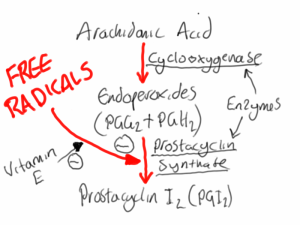Vitamin E is a group of plant derived phenolic isomers. These isomers include alpha, beta, delta and gamma-tocopherol and alpha, beta, delta and gamma tocotrienol. All vitamin E isomers share the same biological activity as alpha tocopherol, the most biologically active of form of vitamin E. Vitamin E is interesting nutritionally because it shows cardioprotective properties in humans. High intakes of alpha-tocopherol for example, may reduce the risk of myocardial infarction significantly, particularly in those who have already suffered a heart attack. It has been speculated that the antioxidant properties of vitamin E are responsible for its ability to reduce heart attack risk. One early theory suggests that vitamin E may reduce lipid peroxidation levels in the low density lipoprotein (LDL) particles, a phenomenon that may be a prerequisite to the formation of atherosclerotic plaques. However, more recently it has been shown that a more simple mechanism may be responsible for the cardioprotective effects of vitamin E.

Vitamin E may protect prostacyclin synthase from damage by free radicals, thus increasing levels of prostacyclin I2 (which is cardioprotective)
The reason that vitamin E may protect from myocardial infarction does relate to its antioxidant effects. However, it might have nothing to do with LDL and the formation of atherosclerosis. Clotting generally occurs in damaged arteries, possibly through scorbutic bleeding as described by Linus Pauling. In healthy arteries arteries however clotting should not occur, and this is prevented by an eicosanoid called prostacyclin I2 (PGI2). Prostacyclin I2 is formed by the enzyme prostacyclin synthase, which is susceptible to free radical damage. Antioxidants like vitamin E may protect prostacyclin synthetase and thus maintain adequate levels of prostacyclin I2. Interestingly antioxidants have also been shown to protect the enzyme nitric oxide synthase from destruction by free radicals. Nitric oxide synthase is responsible for producing nitric oxide, a second messenger that signals the relaxation of blood vessels. Antioxidants such as vitamin E may therefore protect enzymes which are vital to the prevention of myocardial infarctions.
RdB
